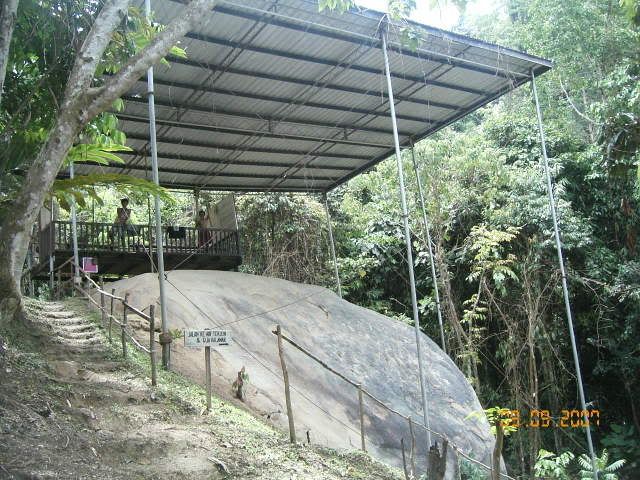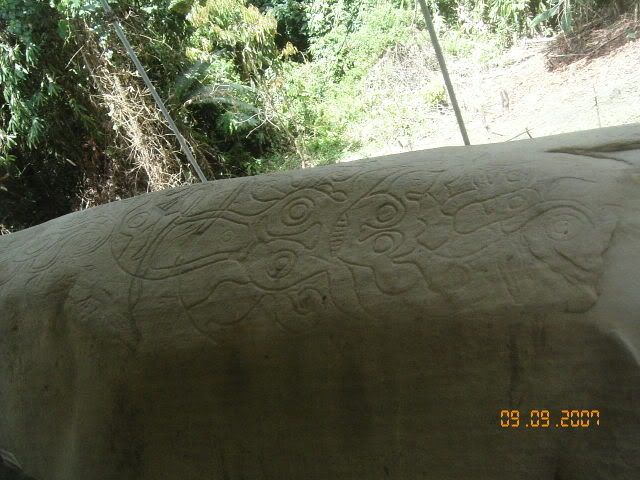Keningau

Location of Keningau town and district in Sabah.
Keningau is a sprawling timber and agricultural town and a district located in the Interior Division of Sabah, east Malaysia on the island of Borneo. It is the oldest and largest district in the interior part of Sabah.
Geography
The Keningau District has an area of about 353,282 hectares or 872,960 acres (1364 square miles) and is situated in a valley surrounded by the Crocker Range to the West and the Trus Madi Range to the East and South. The district consists of 43 'mukim' and 245 villages.[1]
History
The name Keningau is derived from that of the Javanese cinnamon tree (Cinnamomun burmannii) which is abundant in the area. The tree is also known as 'Kayu Manis' in Malay and had also been referred to as the 'king of spice' . The bark of this tree was collected by The North Borneo English Company (Syarikat Inggeris Borneo Utara) to be sold as spice.
Keningau used to be one of the most important administration centres of the British in the early 1900s. The Japanese also made use of Keningau as one of its government's centres during their occupation of Sabah.
The village of Nuntunan in Apin-Apin was known as "44" during British rule. This indicated its distance of 44 miles from Tenom, another British administration centre. Nuntunan was also known as "Office", because the British had its office by the Sg Apin-Apin riverbank, which was later taken over by the Japanese. When the British returned after the Japanese surrender, the remaining Japanese soldiers surrendered at Nuntunan. The locals still believe that the Japanese soldiers had hidden some treasures around the village before their retreat, although this claim has never been properly investigated. Nuntunan, a particularly inaccessible locale, is believed to be the place where the Japanese soldiers hid their shotguns or even their gold treasures.
Demographics
90% of the population in Keningau are Dusun and Murut, 8% are Chinese and other indigenous locals.
Breakdown of ethic groups:
- Dusun - 55,607
- Murut - 23,823
- Chinese - 9,082
- Bajau - 9,009
(Source : Banci Penduduk 2000, Jabatan Perangkaan Malaysia)
The actual population of Keningau is however much larger than the recorded figure above, as illegal immigrants from Indonesia and the Philippines form a major component of the district.These illegal immigrants can enter Sabah easily via the open surrounding seas or the porous inland border with Indonesia.
P/s The word "Kadazan" derived from the Malay word for 'Kedai' meaning shophouses. The modern day Dusuns around Penampang area like to be called " advanced people" unlike their counterparts in the highlands henche the more sophisticated word Kadazan was created by the late Sabah Governer Tun Fuad Stephens (a mixed race of Eurasian and Dusun).
Communications and Transportation
The Keningau township is connected by road through the Kimanis/Papar and Tambunan road from Kota Kinabalu, which is about 138 kilometers in length. Keningau is 67 kilometers from Nabawan, 35 kilometers from Sook and 48 kilometers from Tenom. There is an airport accommodating small aircraft, with flights three times a week from the Kota Kinabalu International Airport by the national carrier of Malaysia, MAS. However, as of 12th November 2006 the service has been suspended due to the upgrading of the airport.
Original site:
http://en.wikipedia.org/wiki/Kundasang
















 Batu Berukir terletak di Kampung Bakuku, Ulu Tomani. Kampung Ulu Tomani adalah terletak 64km dari Pekan Tenom. Perjalanan ke sini akan mengambil masa selam 1 jam 30.minit dengan menggunakan kenderaan pacuan 4 roda. Bagaimana pun untuk sampai ke Batu Berukir, pelawat perlu berjalan kaki selama 30 minit melalui bendang dan anak bukit. Menurut catatan sejarah, batu ini amat istimewa kerana ia adalah artifak tinggalan sejarah yang membuktikan bahawa Tenom telah didiami oleh manusia sejak zaman awal manusia lagi.
Batu Berukir terletak di Kampung Bakuku, Ulu Tomani. Kampung Ulu Tomani adalah terletak 64km dari Pekan Tenom. Perjalanan ke sini akan mengambil masa selam 1 jam 30.minit dengan menggunakan kenderaan pacuan 4 roda. Bagaimana pun untuk sampai ke Batu Berukir, pelawat perlu berjalan kaki selama 30 minit melalui bendang dan anak bukit. Menurut catatan sejarah, batu ini amat istimewa kerana ia adalah artifak tinggalan sejarah yang membuktikan bahawa Tenom telah didiami oleh manusia sejak zaman awal manusia lagi.





